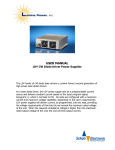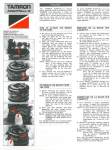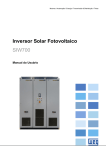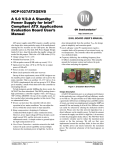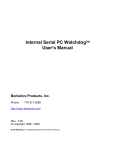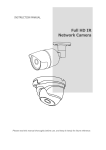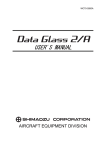Download USER MANUAL preliminary - Schulz Electronic GmbH
Transcript
USER MANUAL preliminary LDD / LDY – LDDHC / LDYHC - CW Laser Diode Drivers LDD- / LDY-series LDDHC- / LDYHC-series 1 2 Overview: The LDD / LDDHC family represents the Lumina Power standard DC power supply for driving high power CW laser diodes. Due to most principle features and control of LDD/LDY resp. LDDHC/LDYHC being identical, in this manual LDD/LDDHC is meant representative also for analogous models of LDY/LDYHC. For differences between LDD / LDY and LDDHC / LDYHC refer to page 5 and Table 1 a) and b) at page 11/12 (interface schematics). As laser diode driver, the LDD / LDDHC power supply acts as a programmable current source and delivers constant current based on the input program signal, which is normally 0 – 10 V. All units are configured with a maximum current and maximum voltage capability, depending on the user requirements. Nomenclature is LDD / LDDHC-zz-xx-yy where zz represents the max. power delivered by the specific unit, xx max. current and yy the max. voltage configuration (refer page 9/10). LDD / LDDHC power supplies will deliver current as programmed into any load, provided that the voltage requirements of that load do not exceed the maximum rated voltage of the unit. SAFETY WARNING Depending on the output configuration of the LDD the output voltage might exceed 48 VDC. Higher voltages than 48 VDC must be considered extremely dangerous, and as such, care must be taken to not touch the output terminals SAFETY WARNING Because LDD / LDDHC units are designed for OEM applications, the user must connect AC input power to the power supply. Any input AC voltage must be considered extremely dangerous, and as such, care must be taken to connect AC input power to the unit. 3 Important notes: With the new revision of the LDD/LDY (from 06/2008 on) besides LDY modells also the LDD-600 – LDD-1500 family includes the following additional features: • • Current Limit Dip Switches: A bank of 4 DIP switches is provided to limit the output current to 16 settings between 110% and 56% of maximum output. This is a useful feature in the event that the diode driver is to be used for multiple applications with some applications requiring less than the maximum rated current of the LDD. Protection circuit against current overshoots: The unit will be disabled immediately in case of an AC power failure to protect the laser diode against current overshoots. Also in case of a load disconnection (e.g. cable break or loose contact) the unit will shut down. -> For automatic restart after an AC failure, option – RE might be choosen although this is not recommended as current overshoots might not be aviodable. Use of –RE is at users own risk. Common features: • • Current Modulation: Although the LDD / LDDHC is designed as CW driver nevertheless it is possible to change the current value fast. If current modulation faster than 20 Hz sinusoidal is planned, the LDD / LDDHC with fast rise option -FR is recommended. LDD fast rise-models are appropriate for sinusoidal current modulation up to 500 Hz. For exemplary values of option -FR refer to Appendix 2. For more information on LDDHC with option -FR please contact Schulz-Electronic. Optional features: If any special configuration or accessory is needed, please contact Schulz-Electronic. Optional accessory: LDD-Contoller - A remote control box LDD-controller is available optionally for current control via 10-turn poti and current and voltage monitoring by display. - For simmering laser diodes below the threshold current of the connected laser diode an adjustable idle current modul can be provided. For details contact Schulz-Electronic. The LDD / LDDHC is a competitive laser diode driver with all basic features for operating high power laser diodes. For even higher functionality LDY / LDYHC series is provided. 4 Optional accessory: Idle current module Features / differences of LDY / LDYHC: The LDY / LDYHC-family is the recommended laser diode driver series, if additional safety features and pulsing capability via TTL-signal are required: 1. LDY/LDYHC contains a crowbar at the output, that is shortend in case of - disabled status - overvoltage detection to protect the connected load. 2. Over voltage protection: LDY / LDYHC detects if the load voltage exceeds the rated voltage. E.g. a LDY-1000-80-12 will shut of if the load voltage requirement exceeds about 12 V. Also in case of a load disconnection (e.g. cable break or loose contact) the unit will shut down. 3. Protection circuit against current overshoots: The unit will be disabled immediately in case of an AC power failure to protect the laser diode against current overshoots. If the control signals to the D-sub interface remained during AC off, at AC recovery the unit will NOT switch by itself. -> Pin 1 has to be disabled and re-enabled to start up the unit again. 4. Current Limit Dip Switches: A bank of 4 DIP switches is provided to limit the output current to 16 settings between 110% and 56% of maximum output (refer to page 19). This is a useful feature in the event that the diode driver is to be used for multiple applications with some applications requiring less than the maximum rated current of the LDD. 5. Pulse control allows fast output on/off by applying a TTL signal to Pin 8 of the control interface (see page 11/12). 6. Over temperature warning: Delivers +5 V output, if internal heat sink temperature exceeds 65 °C. This signal might be used e.g. for switching external fans etc. LDD*1) / LDDHC power supplies utilize a proprietary low loss, high frequency power factor correction circuit which keeps power factor above 0.98. Power factor corrected power supplies use up to 30% less input current and meet stringent IEC harmonic requirements. The output inverter is a state-of-the-art zero voltage switching (ZVS) inverter which permits very high frequency power conversion with minimum losses and electromagnetic noise. *1) LDD-50 is a series pass type power supply (see figure 5). The AC/DC supplies output voltage must be adjusted to the expected load condition for keeping losses low. ð Load voltage must be near max. rated output voltage (e.g. do NOT use a 1 V load with a 3 V rated unit). 5 LDD / LDDHC Diode Drivers - Theory of Operation (Refer to figure 1) The LDD / LDDHC laser diode drivers were designed specifically for the OEM high power CW laser diode systems. OEM power supplies for the laser diode industry have the following requirements: • • • • • • • Safe laser diode operation Broad range of control of output current Safe rise/fall times Small size Power factor correction to conform with CE requirements Low conducted electromagnetic emissions Low leakage for medical applications Referring to the “LDD / LDDHC Laser Diode Power Supply” block diagram (figure 1), the following is a brief description of operation. AC Input Power Circuitry AC input power is processed through a line filter to reduce the conducted EMI to an acceptable level. The LDD / LDDHC line filter has minimum capacitance to ground to minimize leakage currents. Earth Ground stud is provided near the AC input terminals and should be connected to the system ground. To limit the inrush current, the equipment features a NTC resistor in the input circuit. On reaching the operating temperature, the resistor has a low impedance and this means even higher inrush current when switching on the equipment again immediatly after switching it off. The size of the maximum inrush current is limited by the internal resistance of the equipment, the lead resistance and the impedance of the main. So that the inrush current for a cold unit is not exceeded, the power supply has to remain switched off at an ambient temperature of ≤ 25°C for approx. 5 minutes. Depending on the power configuration the inrush current can reach from 20 A up to 50 A at cold start-up. Example for inrush current pulse shape see Appendix 1 Power Factor Correction Boost Inverter The rectified input power is next applied to power factor boost inverter. This inverter boosts the input voltage to 400 VDC. In the process of boosting the input AC voltage, the input AC current is adjusted so that is always in phase with the input AC voltage. Without this power factor correction circuit, the AC input current would be delivered to the power supply in high amplitude, narrow spikes, having a high harmonic content. With power factor correction, the non-50/60 Hz harmonics are reduced to near zero. Since only 6 the fundamental frequency is now used to deliver power, the efficiency of the power supply is improved considerably. One problem with standard input power factor correction circuits is that a high frequency switching circuit is placed across the line in the input side of the traditional input capacitor filter. This results in substantial switching noise conducted to the line. Lumina Power employs a proprietary soft-switching boost inverter which produces minimum switching noise, reduces switching losses, and results in a smaller heat sink associated with the power factor circuit. 7 Zero Voltage Switching (ZVS) Inverter The ZVS inverter and the output transformer are used to step the 400 VDC bus down to the appropriate output value. The ZVS inverter is the most modern high frequency/low loss/low noise topology utilized in power electronics today. Instead of running the inverter in a traditional PWM mode, the inverter is run in a phase shift mode. With the appropriate output inductor and the appropriate capacitance across each switching device, in this case MOSFETS, there are virtually no switching losses in the inverter. The only losses in the devices are I2R losses associated with the Drain/Source resistance of the MOSFETS. Therefore, the ZVS inverter also contributes to reduced losses, reduce EMI noise and a reduction in overall system heatsink requirements. Output Circuit The output filter is a two stage RC filter designed to keep ripple and output noise very low. For lower power units, such as the LDD-250, a single stage filter is used. Control Circuit The control circuit handles all the responsibilities associated with safe operation of the laser diode. Controlled rise and fall times, as well as tight current regulation, overvoltage and over power protection are controlled and monitored in the control circuit. Auxiliary Power All internal power supply requirements as well as the external +/-15 V and +5 V power supplies are derived from the power factor control boost inductor. All auxiliary power supplies are regulated by standard linear regulators. Note: LDD-50 does not incorporate auxiliary outputs. 8 LDD-50- to LDD-3000-xx-yy Specifications xx = Iout, max / yy = Vout, max / xx * yy cannot exceed Pout, max Model LDD-50-xx-yy *1) Pout, max Iout, max Input Voltage *2) Size (L x W x H) 50 W Up to 15 A 90 – 264 VAC 171 x 92 x 83 mm LDD-100-xx-yy 100 W 5 A to 50 A LDD-150-xx-yy 150 W 10 A to 60 A LDD-250-xx-yy 250 W LDD-400-xx-yy *2) 400 W LDD-600-xx-yy 600 W LDD-1000-xx-yy 1.000 W LDD-1500-xx-yy *2) 1.500 W LDD-3000-xx-yy *2) 4.000 W Auxiliary Outputs : *1) *1) *2) 10 A to 80 A 10 A to 100 A 90 – 264 VAC 90 – 264 VAC 190 x 147 x 66 mm 180 – 264 VAC 90 - 264 VAC 251 x 185 x 66 cm 180 – 264 VAC Up to 200 A 180 – 264 VAC 432 x 422 x 86 mm +5 V @ 0.5 A +15 V @ 0.5 A -15 V @ 0.5 A No auxiliary voltages available at LDD-50 LDD-400, LDD-1500 and LDD-3000 input voltage: 180 - 264 VAC Maximum compliance voltage determined by maximum rated power RS-232 option available Other outputs available upon request Input Voltage: Power Factor: See table above > 0.98 Interface Connector: Current Program: Current Monitor: Voltage Monitor: 15 Pin “D” Sub Female 0 – 10 V for 0 – Max. current 0 – 10 V for 0 – Max. current 0 – 10 V for 0 – Max. voltage Performance Pulse Width Range: Rise/Fall Time: Current Regulation:: Current Ripple: Current Overshoot: Power Limit: <2 ms to CW <1 ms (10% to 90% full current), <500 µs with option – FR 0.5% of maximum output current <0.5% of maximum output current <1% of maximum output current Limited to maximum power with power fold-back circuit Environment Operating Temp: Storage: Humidity: Cooling: 0 to 40 °C -20 to 85 °C 0 to 90% non-condensing Forced air Regulatory Leakage Current: <250 µA Approvals Industrial Safety Medical Safety: M90 Emissions/Immunity: LDD-150/250/400/600/1.000/1.500 UL60950 LDD-600/1.000/1.500: UL60601-1, IEC 60601-1, EN 60601-1, CAN/CSA C22.2 No. 601.1FCC 47 CFR Class A Emissions, EN55011:1998 Group 1 Class A Emissions, EN61000-3-2 Limits for harmonic current emissions, EN 610000303 Flicker, EN60601-1-2:2001 Electromagnetic emissions and immunity for medical equipment 9 LDDHC-600- to LDDHC-1.500-xx-yy Specifications xx = Iout, max / yy = Vout, max / xx * yy cannot exceed Pout, max Model Poutmax LDDHC/LDYHC-600-xx-yy 600 W LDDHC/LDYHC-1000-xx-yy 1.000 W LDDHC/LDYHC-1500-xx-yy* 1.500 W Auxiliary Outputs: Ioutmax Input Voltage Size (L x W x H) 90 - 264 VAC 110 A to 200 A 260 x 203 x 70 cm 180 – 264 VAC +5 V @ 0.5 A +15 V @ 0.5 A -15 V @ 0.5 A * LDDHC/LDYHC-1500 input voltage: 180 - 264 VAC Maximum compliance voltage determined by maximum rated power RS-232 Option available Other outputs available upon request Input Voltage: Power Factor: See table above > 0.98 Interface Connector: Current Program: Current Monitor: Voltage Monitor: 15 Pin “D” Sub Female 0 – 10 V for 0 – Max. current 0 – 10 V for 0 – Max. current 0 – 10 V for 0 – Max. voltage Performance Pulse Width Range: Rise/Fall Time: Current Regulation:: Current Ripple: Current Overshoot: Power Limit: <2 ms to CW <1 ms (10% to 90% full current), <700 µs with option – FR 0.5% of maximum output current <0.5% of maximum output current <1% of maximum output current Limited to maximum power with power fold-back circuit Environment Operating Temp: Storage: Humidity: Cooling: 0 to 40 °C -20 to 85 °C 0 to 90% non-condensing Forced air Regulatory Industrial Safety Emissions/Immunity: Designed to comply with UL60950, UL60601.1 Designed to comply with FCC 47 CFR Class A Emissions, EN55011:1998 Group 1 Class A Emissions, EN61000-3-2, EN 610000303, EN60601-1-2:2001 10 The LDD-Family is available from 50 to 4.000 W. The auxiliary power and available approvals depend on the model power and configuration. Please have a look on the actual data sheet overview. LDD-50 – 4.000 / LDDHC-600 – 1500 Interface Connector Type: 15 pin D-sub Female Pin # LDD Pin Name Functional Voltage Level 1 Enable (input) 2 NC (output) 3 Interlock (input) Open = OFF Connect to GND = RUN The Interlock function must be connected to GND in order for output current to be delivered. It can be used for external interlock functions such as door or overtemp. switches. 5 V out, Monitor (output) 0 – 10 V = 0 – Vout, max The output voltage of the supply can be monitored by Vout, Monitor. For LDD’s with a maximum rated output voltage less than 10 V, Vout, Monitor = Vout. For output voltages greater than or equal to 10 V, 0 – 10 V = 0 – Vout, max.. 6 Iout, Monitor (output) 0 – 10 V = 0 – Iout, max The output current of the supply can be monitored by Iout, Monitor . 7 Iprogram(+) (input) 0 – 10 V = 0 – Iout, max The power supply output current is set by applying a 0 – 10 V analog signal to Iprogram(+). 8 NC / (Pulse control for LDD-3000 only) (input) 10 +5 V @ 0.25 A * (output) 11 +5 V @ 0.25 A * (output) 12 -15 V @ 0.5 A * (output) Auxiliary -15 V power supply for user. Up to – 0.5 A output current available. (max. current outout for LDD-100 – 250 = 100 mA) 13, 14 +15 V @ 0.5 A * (output) Auxiliary +15 V power supply for user. Up to +0.5 A output current available. (max. current outout for LDD-100 – 250 = 100 mA) 4, 9, 15 GND Interface return High = RUN = +5 V to +15 V Low = OFF = 0 V Description The Enable function turns the output section of the power supply ON and OFF. When the power supply is enabled, current is delivered to load as programmed via Iprogram(+), Pin 7 if the Interlock, Pin 3 is connected to interface GND. Rise times resulting from Enable are approximately 25 ms. Please do not connect this pin TTL High = On TTL Low = Off The output of the LDD-3000 may be pulsed by applying a TTL signal to Pulse Control, pin 8. The amplitude of the output current pulse is determined by the current level programmed via Pin 7, Iprogram(+). Rise fall times of <1msec are typical. If left unconnected, the default will be ON for CW operation. Auxiliary +5 V power supply for user. Up to 0.5 A output current capability on Pin 10 and 11 together. (max. current outout for LDD-100 – 250 = 100 mA) * no auxiliary power output for LDD-50 Table 1 a: LDD / LDDHC Interface For more detailed interface information please refer to figure 2 11 LDY-600 – 1500 / LDYHC-600 – 1500 Interface Connector Type: 15 pin D-sub Female Pin # LDD Pin Name 1 Enable (input) Functional Voltage Level Description High = RUN = +5 V to +15 V Low = OFF = 0 V The Enable function turns the output section of the power supply ON and OFF. When the power supply is enabled, current is delivered to load as programmed via Iprogram(+), Pin 7 if the Interlock, Pin 3 is connected to interface GND. Rise times resulting from Enable are approximately 25 ms. High = Crowbar OFF = +5 V Low = Crowbar ON = 0 V The Crowbar Status reports the status of the shorting crowbar clamp across the output. The crowbar will short the output under two conditions: 1) When the output is not ENABLED via Pin 1, or, 2) if the output is ENABLED via pin 1 but the control circuitry has detected a no- load condition or a voltage requirement on the output that exceeds the maximum voltage rating of the unit. A TTL+5V signal on Pin 2 reports that the crowbar is shorting the output. To turn the crowbar off, an appropriate load must be connected to the LDD and the output must be turned off and on via Pin 1, ENABLE. 2 Crowbar status (output) 3 Interlock (input) Open = OFF Connect to GND = RUN The Interlock function must be connected to GND in order for output current to be delivered. It can be used for external interlock functions such as door or overtemp. switches. 5 V out, Monitor (output) 0 – 10 V = 0 – Vout, max The output voltage of the supply can be monitored by Vout, Monitor. For LDD’s with a maximum rated output voltage less than 10 V, Vout, Monitor = Vout. For output voltages greater than or equal to 10 V, 0 – 10 V = 0 – Vout, max.. 6 Iout, Monitor (output) 0 – 10 V = 0 – Iout, max The output current of the supply can be monitored by Iout, Monitor. 7 Iprogram(+) (input) 0 – 10 V = 0 – Iout, max The power supply output current is set by applying a 0 – 10 V analog signal to Iprogram(+). TTL High = On TTL Low = Off The output may be pulsed by applying a TTL signal to Pulse Control, pin 8. The amplitude of the output current pulse is determined by the voltage programmed via Pin 7, Iprogram(+). Rise fall times of <1 ms are typical. Rise fall times of <500 µs can be achieved with special order. When using the LDY / LDYHC as a CW diode driver, pin 8, the Pulse Control, must be set to TTL High in order for output current to be delivered. Pin 10, +5V, would be a convenient connection point for this. No output current will be delivered with pin 8 left unconnected. 8 Pulse control (input) 10 +5 V @ 0.5 A * (output) 11 Over-Temp warning (output) 12 -15 V @ 0.5 A * (output) Auxiliary -15 V power supply for user. Up to – 0.5 A output current available. 13, 14 +15 V @ 0.5 A * (output) Auxiliary +15 V power supply for user. Up to +0.5 A output current available. 4, 9, 15 GND Interface return Auxiliary +5 V power supply for user. Up to 0.5 A output current capability on Pin 10 and 11 together. TTL High = High Temp TTL Low = Temp OK When temperature of main heat sink exceeds 65 Deg C, Pin 11, the OverTemp Warning, will go to a TTL High to indicate unit is in danger of shutting down due to over-temperature condition. When temperature of main heat sink exceeds 75 Deg C, unit will shut down. Table 1 b: LDY / LDYHC Interface 12 Figure 1: LDD / LDDHC block diagram Figure 2: LDY interface 13 Figure 3: LDD-50 block diagram Figure 4: LDD-50 interface 14 INSTALLATION AND OPERATION OF LDD / LDDHC LASER DIODE DRIVERS Important installation notes LDD / LDDHC diode drivers are air cooled by internal fans. Do not restrict air flow near the input or output air vents of the power supply. If the unit overheats due to restricted air flow, it will shut down and remain off until the unit has cooled to a safe operating temperature. LDD / LDDHC units should be mounted in systems using 8-32 (or M4) bolts to secure the mounting flanges to mounting plate. Figure 5: LDD / LDDHC Input Connections Figure 6: LDD / LDDHC Output Connections 1. CONNECTING TO DIODE LASER: Figure 6 shows the location of the LDD / LDDHC output terminals. Connect diode laser load to the output terminals. Although CW diode laser applications are generally free of voltage spikes associated with high speed QCW applications, it is still good practice to keep connections between the diode laser and power supply as short as possible to avoid I2R losses in the wire. 2. INTERFACE CONNECTION: Connect user system to 15 pin D-sub connector. The user interface is typically designed by the user, Lumina Power can provide any assistance necessary to modify interface program and monitor levels. See Table 1 and Figure 2 for description of LDD / LDDHC interface and the associated simplified interface schematic. Important note Make sure when connecting interface that the current program setting, Iprogram(+), is set no higher then the value required for operation. When AC power is applied and system is Enabled, output current will rise to this program value. 15 3. AC INPUT POWER CONNECTION SAFETY WARNING Because LDD / LDDHC units are designed for OEM applications, the user must connect AC input power to the power supply. Any input AC voltage must be considered extremely dangerous, and as such, care must be taken to connect AC input power to the unit. Important note - AC input wires should be at least #16 AWG, rated for at least 300 V at 105 °C - LDD / LDDHC units are fused on both input lines. It does not matter which of the two AC inputs are designated Line or Neutral Connect AC power connections to power supply input power terminals as follows: • Neutral wire (16 AWG) connected to the right contact of the AC input terminal. • Line wire (16 AWG) connected to the left contact of the AC terminal block. • Ground wire shall be crimped to a #8 ring-lug and connected to the ground stud. LDD Model: CE Med 60601-1 UL 60950 LDD-50 LDD-100 ü ü ü ü LDD-150 ü LDD-250 ü LDD-400 ü ü LDD/LDY-600 ü ü LDD/LDY-1000 ü ü LDD/LDY-1500 LDD-3000 ü ü ü LDDHC/LDYHC-600 ü ü LDDHC/LDYHC-1000 *1) ü contact Schulz-Electronic ü LDDHC/LDYHC-1500 For further information please Input 90 - 264 VAC 90 - 264 VAC ü ü ü ü ü ü ü ü ü 90 - 264 VAC 90 - 264 VAC 180 - 264 VAC 90 - 264 VAC 90 - 264 VAC 180 - 264 VAC 180 - 264 VAC 90 - 264 VAC 90 - 264 VAC 180 - 264 VAC Table 2: LDD/LDY – LDDHC/LDYHC approval overview and input voltage 16 MODEL LDD-100 LDD-150 LDD-250 LDD-400 LDD/LDY-600 LDD/LDY-1000 LDD/LDY-1500 LDDHC/LDYHC-600 LDDHC/LDYHC-1000 LDDHC/LDYHC-1500 INPUT POWER Input: 100 – Input: 100 – Input: 100 – Input: 200 – Input: 100 – Input: 100 – Input: 200 – Input: 100 – Input: 100 – Input: 200 – 240 VAC, 50/60 240 VAC, 50/60 240 VAC, 50/60 240 VAC, 50/60 240 VAC, 50/60 240 VAC, 50/60 240 VAC, 50/60 240 VAC, 50/60 240 VAC, 50/60 240 VAC, 50/60 Hz, 2.4 A – 1 A. Hz, 3.6 A – 1.5 A Hz, 6.5 A – 3 A Hz, 6 A – 4.5 A Hz, 11.5 A – 5.5 A Hz, 15 A – 6.5 A Hz, 9.5 A – 7.5 A Hz, 13.5 A – 6.5 A Hz, 17 A – 7.5 A Hz, 11 A – 8.5 A June 10 Table 3: LDD/LDY, LDDHC/LDYHC AC input power requirements 4. OPERATING THE DRIVER Switch on procedure: The unit may be programmed for output current via Pin 7, the Iprogram function. But there are two interface control signals which must be properly set before the output will deliver current as programmed by Iprogram. a. AC-power must be connected b. INTERLOCK: Pin 3, the Interlock, must be grounded via Pins 4, 9 or 15 to let the output section be activated by the ENABLE Pin 1. c. ENABLE: Pin 1, the ENABLE signal is a +5 V to +24 V signal used to turn the output section on. The ENABLE circuitry incorporates a soft start function which ensures rise times of approximately 15 to 20 ms. d. Iprogram: Pin 7, an analog 0 – 10 V signal results in 0 to Iout, max, as long as the rated compliance voltage of the driver is not exceeded CH 1 Iout 20A/div CH 2 ENABLE Figure 7: Response of Iout to ENABLE signal 17 CH 1 Iout 20 A / div CH 2 Pin 8: TTL Figure 8: Typical LDD /LDY rise fall time It is possible to configure LDD / LDY’s for rise and fall times up to 500 µs, which would permit pulsing up to 600 Hz (Figure 8). Consult Schulz-Electronic for faster rise/fall times. Typical rise/fall times for LDDHC / LDYHC are up to 1 ms. Pulsed output is delivered when fast switching the current programming signal (pin 7, Iprogramm(+)) between low/high (LDD and LDY) or switching pin 8 between TTL low/high (LDY only). NOTE: It is not possible to use Enable, Pin 1, for pulsing since the ENABLE circuit includes a “soft start” is intended for turning on the power supply output slowly (see figure 7). The Enable function controls several soft-start features which do not permit pulsing. NOTE: For faster pulsing, refer to the data sheet for Lumina Power’s LDQCW power supplies. These units have rise/fall times of less than 25 µs and can achieve output currents up to 200 A. These units can pulse at frequencies up to 5 kHz, depending on the average power required. ð For further information contact Schulz-Electronic. 18 Important note If the unit is first enabled and AC power is switched on afterwards, the unit will not deliver current. The unit will need to be reset first: The unit must be disabled and enabled again. LDD-100 – LDD-1500 and LDY/LDYHC: In case of voltage overshoots due to e.g. a loose contact at the output or in case of a short AC drop out the unit will immediately shut down and will also need to be reset again. For automatic start up after a safety shut down option – RE is available. 5. MONITORING LDD / LDDHC OUTPUT AND PERFORMANCE: a. Current Monitor: Power supply output current can be monitored via pin 6, Iout, monitor : A 0 – 10 V signal will represent the output current from 0 to maximum rated output current. b. Voltage Monitor: Power supply output voltage can be monitored via pin 5, Vout, monitor : A 0 – 10 V signal will represent the output voltage from 0 to maximum rated output voltage. 6. Programmable Current Limit DIP Switches The LDD-/LDY-600 – LDD-/LDY-1500 includes an internal DIP switch array which may be set to limit the maximum current. This is useful when an OEM customer would like to use a single model for a variety of systems, but has a laser diode system which does not require the maximum output current. In this type of situation, it is important to protect the laser diode from an over-program error which could damage the laser diode. The following table shows the various DIP switch settings and resulting output current. S1 S2 S3 S4 Imax, out OFF OFF OFF OFF 110% OFF OFF OFF ON 103% OFF OFF ON OFF 98% OFF OFF ON ON 92% OFF ON OFF OFF 88% OFF ON OFF ON 84% OFF ON ON OFF 80% OFF ON ON ON 77% ON OFF OFF OFF 74% ON OFF OFF ON 70% ON OFF ON OFF 68% ON OFF ON ON 65% ON ON OFF OFF 63% ON ON OFF ON 60% 19 ON ON ON OFF 58% ON ON ON ON 56% For example, if an LDD is configured for a maximum output current rating of 60 A, and the maximum output current should be limited in a particular application to 40 A, the DIP switch array should be set as follows: S1 S2 S3 S4 Imax, out ON OFF ON OFF 68% This will limit the current to 68% of 60 A, means approx. 40 A. When the unit is programmed with a 0 - 10 V signal, the output will follow the programming voltage until the analog signal reaches 6.8 V. Programming to more than 6.8 V, means 68% of 10 V, the output current will not rise any further. Units are shipped with all switches in the OFF position (upwards position), which results in the ability to program the unit with up to 110% programming voltage. Nevertheless the output current will never exceed 100% of the maximum rated current. Important application note When the power supply is enabled using the ENABLE signal, internal soft start function limits the rise time of the output current to approximately 20 ms. Once the power supply is enabled, the rise/fall time caused by Iprogram(+) signal is approximately 600 µs (LDD / LDY) / 1 ms (LDDHC / LDYHC). Important application note When the internal heat sink temperature reaches 75 °C, the unit will shut down. Servicing Lumina Power laser diode drivers All modells LDD / LDY / LDDHC / LDYHC have no serviceable parts. Do not attempt to repair or service this unit in the field. For further information, contact Schulz-Electronic: [email protected] +49 (0)7223 9636-48 20 Appendix 1 Example of LDD inrush current LDD-600-85-3 (Input section the same for LDD/LDY-600/1000/1500) Input = 115 VAC / 60 Hz Ch: 2 = 10 A / division Ipeak < 50 A Appendix 2 Option – FR / current modulation The fast rise option allows steep rise and fall times of under 500 µs. Additionally fast modulation is possible. E.g. a unit LDY-1500-80-19-FR was tested to approximately following limits: - Sinusoidal modulation up to 500 Hz between 20 and 100% current amplitude - Stepwise modulation of the output current between 70 and 90% load. The unit follows with a slew rate of ca. 16 A/100 µs and a regulation delay of 50 µs. Here current modulation is possible up to a sampling rate of 4 kHz at programming steps of ±20% every 250 µs. 21 Appendix 3 Guidelines EN55011 Class A Lumina products comply with EN55011:1988 Group 1 Class A Emissions. These products are designed for industrial application and hence comply with this guideline in respect of emission and immission in industrial environment. They may not comply with domestic standard (class B) regarding emission. RoHS EU Guideline 2002/95/EG The reduction of the pollutants in the products of the electrical industry is an important contribution to the environment protection which earns the biggest support from us all. This rearrangement process was concluded at Lumina Power Inc. in year 2007. All Lumina Power laser diode drivers, which are produced after 2007 are RoHS-compliant. 22























